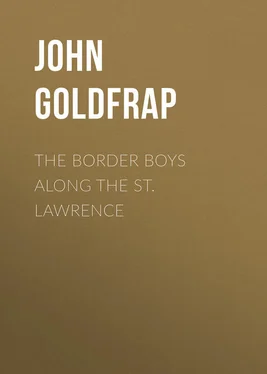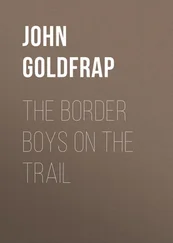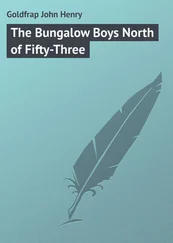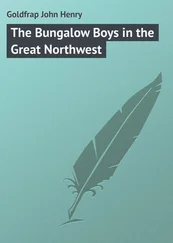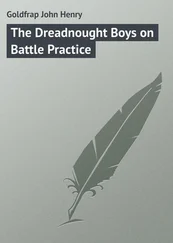John Goldfrap - The Border Boys Along the St. Lawrence
Здесь есть возможность читать онлайн «John Goldfrap - The Border Boys Along the St. Lawrence» — ознакомительный отрывок электронной книги совершенно бесплатно, а после прочтения отрывка купить полную версию. В некоторых случаях можно слушать аудио, скачать через торрент в формате fb2 и присутствует краткое содержание. ISBN: , Жанр: foreign_prose, на английском языке. Описание произведения, (предисловие) а так же отзывы посетителей доступны на портале библиотеки ЛибКат.
- Название:The Border Boys Along the St. Lawrence
- Автор:
- Жанр:
- Год:неизвестен
- ISBN:http://www.gutenberg.org/ebooks/51600
- Рейтинг книги:3 / 5. Голосов: 1
-
Избранное:Добавить в избранное
- Отзывы:
-
Ваша оценка:
- 60
- 1
- 2
- 3
- 4
- 5
The Border Boys Along the St. Lawrence: краткое содержание, описание и аннотация
Предлагаем к чтению аннотацию, описание, краткое содержание или предисловие (зависит от того, что написал сам автор книги «The Border Boys Along the St. Lawrence»). Если вы не нашли необходимую информацию о книге — напишите в комментариях, мы постараемся отыскать её.
The Border Boys Along the St. Lawrence — читать онлайн ознакомительный отрывок
Ниже представлен текст книги, разбитый по страницам. Система сохранения места последней прочитанной страницы, позволяет с удобством читать онлайн бесплатно книгу «The Border Boys Along the St. Lawrence», без необходимости каждый раз заново искать на чём Вы остановились. Поставьте закладку, и сможете в любой момент перейти на страницу, на которой закончили чтение.
Интервал:
Закладка:
“What river is this?” he asked.
One of the Indians pointed majestically to the west.
“The river without an end,” he said solemnly.
Cartier found the Indians extraordinarily skillful in managing their frail birch bark canoes, even in the wildest of the rapids. He was greatly interested in all the different tribes which he encountered. Many of them were at war with each other, although all sprang, according to present-day opinion, from the Cree stock.
The old French traveler says that he found the Indians friendly. He describes a visit to one of their towns, which stood at the base of a hill surrounded by cornfields, with the river and the primeval forest beyond. This village, occupied by a tribe known as the Amerinds, was well fortified, as were all the villages of this tribe, by a high stockade.
With a body guard of twenty of his men Cartier entered the walled village. They found inside the stockade a gallery from which missiles could be hurled down on any foe. Piles of stones lay in readiness for this purpose.
Behind the village stood an imposing height of land which Cartier, impressed by the noble view from its summit, named Mont Royale. This was the origin of Montreal, which city stands on the site of the stockaded Indian village of Hochelaga.
It was too late in the season when the bold investigator reached this village to press on further, and he therefore made his way back to winter quarters at Havre de St. Croix on the St. Charles River. His experiences during the “white winter,” as he called it, were enough to daunt even his courageous spirit. To add to his troubles, his men contracted scurvy, and many died before spring came, from the close confinement and lack of proper food.
The Indians brewed for the sufferers a sort of tea of pine boughs and bark called “ameda,” which appeared to have a good effect on the victims and, in Cartier’s opinion, saved the lives of many of them.
He returned to France and, some time later, made a third voyage. This time it was a trip for colonization. But the little colony suffered terrible privations and much illness and misery, and it was to the Indians that they owed what succor in the way of provisions and primitive medicine they were able to obtain. Cartier sailed back to France, leaving the remnants of the colony, and never returned again.
Then came Champlain, the founder of Quebec. It is a far cry from the noble city of Quebec as it is to-day to the huddle of huts erected in the form of a square by Champlain, and surmounted by a dovecote on the top of a pole to symbolize his peaceful intentions. Of his discovery of the historic lake that bears his name it would be beside the mark to speak here, inasmuch as this necessary digression is simply to acquaint our readers with a little of the history of the river on which our Border Boys were destined to meet such surprising adventures, and with the city of Montreal, to which they were now bound.
CHAPTER V
DOWN TO MONTREAL
The run down the river to Montreal was made rapidly and without incident. The boys found the slow progress they had to make through the canals adjoining the Lachine and Long Sault rapids, which they could not descend, rather tedious. Nevertheless, they thoroughly enjoyed watching one of the red-funneled excursion steamers from up the river shoot through the boiling waves and cascades, apparently to certain destruction.
At the Lachine Canal they were “locked down” eighty-two feet, passing through three locks in the process. They arrived at Montreal, Canada’s “White City,” that evening. The next morning they devoted to seeing the sights of the town.
Perhaps some extracts from a letter written some days later by Ralph to a school chum will give our readers a boy’s idea of this city and of Quebec.
“About the first thing we noticed,” wrote Ralph, “was the Victoria Bridge, which spans the south channel of the St. Lawrence and carries the rails of the Grand Trunk Railway. It is almost two miles long, has twenty-four spans, and hangs sixty feet above the river. We saw it first in the twilight. It looked like a black ribbon stretched across the sky.
“Montreal is the queerest city from the point of view of design that I ever saw. It is built up from the river in a series of terraces. It is chock full of fine buildings, as fine and finer than any in New York, but of course not so tall. There is the big cathedral of Notre Dame, with twin towers like the one in France. It has a bell weighing 24,780 pounds, the heaviest bell in North America. The church will seat fifteen thousand people.
“The ice cream sodas here are not good. We know, for we sampled them. But I was going to tell you, under Notre Dame Street are buried the bones of Le Rat, a Huron chief, who broke the peace pact between the French and his tribe. He fell dead as a door nail while addressing a lot of Hurons and French who had come together to have a pow-wow.
“We didn’t spend very much time here, however, being anxious to get on to Quebec. Besides, something happened the other night at the island that we are anxious to get back to solve. I can’t tell you more about it now than to say that it was a ‘ghost ship’! That sounds promising, doesn’t it?
“Now, to tell you something about Quebec. I am mighty glad to have been there. It is truly a wonderful city. Somebody told us that it got its name from Cartier exclaiming, as he saw the three-hundred-foot rock that rises from the river, ‘ Que bec! ’ Knowing that you are not much of a French scholar, I will translate. That means ‘What a beak!’ And so that is how Quebec got its name, and, if you’d ever seen it, you would think it was a good one.
“I can’t describe the city better than to call it a huge cliff all stuck over with spires, roofs, chimneys, ramparts and muzzles of antiquated guns that a modern piece of artillery could knock into a cocked hat. Cape Diamond, as the immense rock is called, is all tufted with patches of shrubs. It made me think of Professor Crabtree’s face. You know: all hard and rugged, with whiskers scrawling over it!
“The Lower Town, as it is called, lies at the base of this rock. Here is the water-front section, and streets that turn and twist about like corkscrews. It is a smoky, ancient, old place full of queer smells and business.
“You get out of it to the Upper Town by Mountain Street, and it’s all of that! They say that till thirty years ago a carriage couldn’t get up it, but it has been graded so that now you can drive up. We walked, thinking it would be good exercise for Persimmons, who hates walking, anyhow.
“The citadel is a wonderful place perched up on a high rock, and you can see all over the region from it. One thing to be seen there is a brass cannon the Britishers captured at Bunker Hill. No wonder they’re proud of it. I guess it’s about all they did get.
“The Citadel runs, in the form of a big granite wall with towers and bastions stuck on it at regular intervals, all along the brow of the height overlooking the city, like a wrinkle on a forehead. Quebec, as perhaps you know, is the only walled city in America. It certainly is a great place to see. You might think that you were looking down from the Citadel on some old town in the middles ages – except for the tourists with their cameras!
“We went out to the Plains of Abraham; that is, Persimmons didn’t go, having overeaten on some cake he made himself and we wouldn’t touch, having sampled his cooking before. This is the place where Wolfe licked Montcalm. But both their names are carved on a monument just as if they had fought side by side.
“In the Post Office, where I am going to mail this letter, there is a block of granite from an old building that once stood on its site. It was called the Chien d’Or , or the Golden Dog. There is a story connected with Phillibert, the merchant who built it. He came here when Bigot, a ‘grafter’ or ‘boss,’ as we should call him nowadays, had control of the city and of New France. He ran things to suit himself and pocketed all kinds of crooked money. Phillibert ran a sort of department store and fought Bigot all he could. Over the door of his store he had the figure of a dog cut. It was gnawing a bone. The dog was meant to be Bigot and the bone the country he was ‘grafting’ on. Bigot got so sore at this that he had his brother-in-law assassinate Phillibert.
Читать дальшеИнтервал:
Закладка:
Похожие книги на «The Border Boys Along the St. Lawrence»
Представляем Вашему вниманию похожие книги на «The Border Boys Along the St. Lawrence» списком для выбора. Мы отобрали схожую по названию и смыслу литературу в надежде предоставить читателям больше вариантов отыскать новые, интересные, ещё непрочитанные произведения.
Обсуждение, отзывы о книге «The Border Boys Along the St. Lawrence» и просто собственные мнения читателей. Оставьте ваши комментарии, напишите, что Вы думаете о произведении, его смысле или главных героях. Укажите что конкретно понравилось, а что нет, и почему Вы так считаете.
